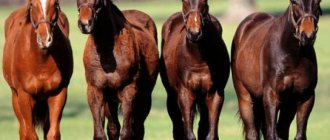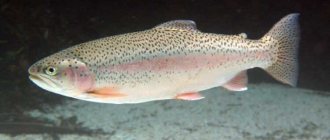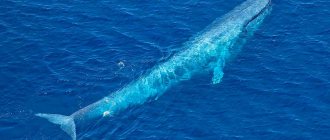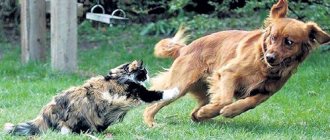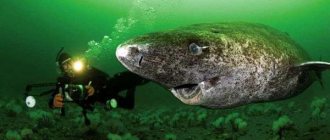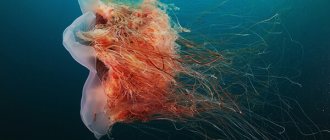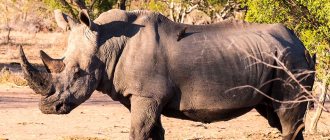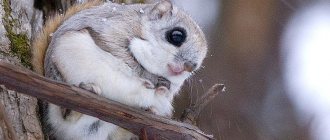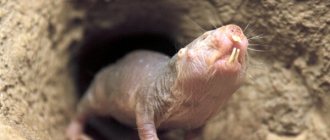Representatives of salmon live in the cleanest bodies of water, fresh and salt water, seas and oceans, rivers, lakes, and mountain streams. Preference is given to reservoirs with cool water temperatures, the optimal value is up to +14°.
When the temperature rises on hot summer days, the fish goes to cool places, under waterfalls, and hides behind boulders. Ocean species are not so demanding on temperature conditions; they feel comfortable at +20°.
Trout is a representative of the “noble” fish family
Many fishermen know what trout fish looks like. The body is flattened on the sides, the head is short in relation to its length, cut off in front. On the upper part there are two rows of sharp teeth, at the bottom there are only 4. In mature males, a curved fang grows in the center on the edge of the lower jaw.
Trout belongs to the salmon family. Descriptions of the main indicators are presented in the table:
| Class | Ray-finned |
| Squad | Salmonidae |
| Family | Salmonidae |
| Genus | Salmon |
| View | Stream, lake, rainbow |
| Security status | Medium (some countries have banned commercial fishing) |
| The average size | From 20 cm to 1.5 m |
| Lifespan | 7 years |
| Diet | Predator – fry, eggs, worms, bugs |
| Optimal feeding time | Early morning, late evening |
| Enemies | Burbot, grayling, young trout, seals, bears, birds |
| What do they bite on? | Fly, bloodworm, grasshopper, caviar, wobbler |
The family has several groups that depend on their natural habitat. The main types of trout are:
- stream;
- lake;
- rainbow.
The main color of the dorsal part is yellow-brown with a light green tint, along which there are black spots with a light rim. The lower part of the belly is relatively light, copper or orange in color. The lower fins are yellowish, the upper ones are dark with black dots.
Color shades vary depending on the habitat where the trout lives, food, and water pollution. In clean reservoirs the fish are almost colorless; in deep muddy places the fish are dark, almost black.
The color changes to dark tones in spring or autumn before spawning. Also, the coloring depends on the fatness of the individual - the fatter the animal, the blurrier the bright colors and inclusions, and the spots and stripes completely disappear.
By gender, representatives differ in size and weight. Males have a larger head, but weigh slightly less. The lower jaw bone is bent upward in the center, and towards puberty it grows into a large upward-curved growth.
When cut, trout meat is light, orange or reddish in color.
Trout in cooking
Trout, like all red fish, is a delicacy. The average calorie content of fillet is 120 kcal per 100 grams. Some cooking methods increase the energy value of meat up to 220 kcal.
The most useful components included in the chemical composition of trout are Omega-3 and Omega-6 fatty acids, vitamins A, E, B12, folic acid, potassium, phosphorus, magnesium, sodium. When eaten regularly, fish helps normalize metabolic processes and accelerates the production of red blood cells. The benefit of trout is to improve the condition of blood vessels and activate the brain.
Features of trout culinary processing include the following:
- when cutting fish, the head is separated and not used for cooking due to the harmful substances it contains;
- Baked trout is considered the most delicious; when baking, the carcass should be wrapped in foil to preserve its juiciness;
- Citrus fruits, ginger, olives, white wine, cream or sour cream will help complement and emphasize the taste of red fish.
When buying trout, you can determine freshness by the absence of odor, transparent eyes, elastic flesh, pink or bright red color of the gills. If the carcass will not be used immediately, it must be gutted and washed inside and out. The optimal temperature for storing fish is 0-+2 degrees.
How to distinguish a female from a male trout
Trout caviar is no less healthy than meat. It is salted and used to make sandwiches, sushi and rolls. You can identify trout with caviar by the following characteristics:
| Females | Males |
| Small head and large body | The body is smaller, the head is much larger in relation to the overall size, the color is brighter |
| The jaws are the same | The lower jaw is extended and curved upward, the number of teeth in the mouth is greater than that of the female |
| Smooth body arcs | There is a hump on the back |
The female with the eggs has a dense abdomen, and the opening is widened and colored pink. Sexual maturity occurs in trout at 3-4 years, so caviar can only be found in fish of the appropriate size for this age.
Varieties of the species
Atlantic trout has many subspecies, including anadromous ones, into which there is an easy transition when moving from one body of water to another.
1.The main varieties include the genus of loaches:
- silver;
- lake;
- river;
- big-headed;
- Dolly Varden;
- American palia.
2.Pacific salmon includes:
- rainbow;
- golden sea;
- Caucasian;
- Apache fish;
- Gila trout.
3. The following are considered noble representatives:
- marble;
- Ohrid;
- Adriatic;
- Amur Darya;
- brown trout;
- Sevan
The family has the basic characteristics of the genus. What a representative looks like, what unites the groups, an example demonstrates the main differences.
Application
Trout fish is used to prepare a variety of dishes. It is perfect for boiling, stewing, frying, baking in the oven, and smoking. Its meat can even be eaten raw. Trout caviar is a gourmet product.
Descriptions of fish
A distinctive feature is a lateral longitudinal pink stripe with bordered brown spots (the distinctive features of river trout are visible in the photo). The belly is much lighter without spots. The color of the lower pelvic fins is orange, the upper and dorsal fins are black. The river where trout is found is characterized by fast currents, whirlpools, and crystal cold water.
Average parameters: length 25-70 cm, weight 2-7 kg. In deep forest lakes, individuals grow huge: up to 115 cm in length, weight reaches 23-25 kg.
Reviews about trout fishing
I'm a big fan of trout fishing. I usually go to the lake when the ice begins to break up. The best time ever! I pull out specimens up to half a kilogram, 4-5 pieces at a time. Grade:
Alexey Mishcheryakov
It is excellent to catch trout in cool water using various spinning wobblers, for example, Pontoon21 Crackjack 38, both in regular colors and in the so-called “Aryan colors”. Grade:
Dmitriy
When fishing for trout on paid ponds, I use the following gear: a rod 203 centimeters long, which is specially made for trout fishing - such a spinning rod is sensitive and light. I use it for spinners and small spinners, weighing up to 3-4 grams. I also use a 219 centimeter long rod and 4-7 g jigs. And wobblers 4-6 centimeters and weighing up to 10 grams. Grade:
Maksim
My friends and I go fishing for trout on paid fishing grounds in the near Moscow region: you can get there conveniently and quickly, and the fishing is a lot of fun. You can experiment with different tackles and baits, and trout specimens are usually found at least 40-50 centimeters in length. Grade:
Anatoly
Trout can be found not only in the wild, where it mainly chooses reservoirs with cool and clean water, but you can also go fishing for this amazing fish not far from home: now there are many paid reservoirs regularly stocked with trout. Therefore, the choice remains with the fisherman; you just need to choose the right place to fish and select tackle and bait.
Habitats
The river specimen lives in freshwater places, but adapts to any salinity of water. Some individuals live without changing their habitat. After spawning, they go into holes at the bottom of the river near springs. In this place, the school can live until spring, eating small fish, worms, and crustaceans. In spring, fish move to waterfalls, under steep banks, and to areas where it is cool.
A few shoals are found in Lake Onega, Lake Ladoga, and in reservoirs in Karelia and the Kola Peninsula. Representatives live in the Caucasus, in Lake Sevan. In cold summers, shoals are located at a depth of 10-15 meters; in hot weather they move to cool places.
Habitat of trout fish
Trout is found everywhere in Russia: in southern and northern rivers, in the Pacific Ocean, in the Barents, Baltic, North Seas and in the south in the Black and Caspian Seas. Many trout can be found in streams and rivers of the Kola Peninsula and in Karelia.
As a fish, trout has been cultivated in Russia since 1895, it was then that the first fish farms began to appear on the Caspian Sea and the Volga. Now trout farms are located throughout Russia.
Sea trout is grown mostly in the Caspian and Black Seas, and river trout is grown both in rivers and on individual farms, including far from rivers.
Sport fishing for trout is a very exciting activity, as it is a very careful and attentive fish. Therefore, calculating the most fishy places for successful fishing is already quite difficult.
Trout are usually caught using fishing rods with floats, fly fishing or using a spoon. In the Caspian Sea, trout are also hunted using nets.
Reproduction
The ability to spawn occurs after three years. Trout spawn at different times than representatives of other families. Females spawn in the fall or early winter months. Air temperature and habitat are indicators of the beginning of spawning. When summer ends, trout begin to move to their spawning grounds, to the sources of rivers.
The spawning site is selected in shallow water up to 1 meter deep with small pebbles or pebbles at the bottom. The tail sweeps sand at the bottom and creates a hole for laying eggs. Orange 5-mm eggs are laid in it.
Each female spawns in several approaches, morning and evening, throughout the week. Only sexually mature strong males are allowed to approach the eggs for fertilization. After this, the hole is closed so that the fast current does not carry away the eggs.
Large eggs (the size of peppercorns) ripen for 2-3 months, depending on the ambient temperature. After birth, small fry are up to 2 cm in size; they are fed using the yolk sac, which remains after hatching. After a few days, the fry feed on plankton.
Gradually, the fry move down the river with the current. The young generation of trout feeds on what adults do: flies and mosquitoes, their larvae, eggs of other families, small fish. By autumn they grow up to 10 cm, by the age of two they grow and repeat the path of their ancestors.
Natural enemies of trout
For eggs, the enemy is pike, grayling and the adult trout itself. Most young fish die in the first year of life - about 95%. Then the figure drops to 50%.
Interesting! When trout sense danger or are hunting, they can accelerate up to 18 km/h.
Adults have no less enemies. They remain attractive prey for burbot, brown trout, bears, and seals.
Distinctive features of the variegated species
Varieties of this genus have a similar elongated shape. The body has a hard, small scaly covering. Fins and tail are medium in size. The rainbow specimen is famous for its attractive, vibrant, patterned skin, hence its name.
Shades vary depending on gender, habitat, maturity. The bright brown color of the hindquarters fades into an olive or dark blue tone with a radiant sheen. The middle stripe is colored pinkish, the belly has a pearlescent tint. The upper part is covered with dark spots with a white or blue border.
The salmon family are carnivores that eat virtually all organic food, including leftovers and entrails. They grow up to 2 meters, weigh up to 45 kg, and in natural conditions live up to 6 years.
The adult spawns after 4 years of life and reproduces in the spring from March to April. The eggs are large, like peas. During one throwing, the female lays up to 2000 eggs. The fry emerge from the eggs after two months. They grow faster than river varieties and adapt at +20°. The family is used for keeping in artificial cages and fish farms.
The rainbow individual is part of a group known as black spotted (due to the similar spots on both bodies). They can interbreed with species of spotted trout, Mexican golden trout, and Gila trout without changing their habitat.
Spawning process
Spawning occurs in October-November. Some species spawn in the spring. During such periods, trout does not refuse food like salmon, but consumes it in reduced quantities. To spawn, mature fish go to shallow water, where the average depth does not exceed 1-1.5 meters.
Reproduction occurs in stages:
- Females look for areas with a bottom covered with sand and small pebbles.
- Using their tail, females dig a hole where they lay eggs (up to 12,000 in one go).
- Approaching a close distance to the laying site, the male releases mature milt into the water.
- After fertilization, the female sprinkles the eggs, trying to protect them in this way from being eaten by other underwater inhabitants.
- Spawned fish go to greater depths to regain lost strength and fatten up.
Yandex pictures
Worth knowing! Different species of trout choose different areas for procreation. The rainbow fish seeks calmer waters because its eggs are not naturally sticky and are easily carried away by the current. The stream variety spawns in fast-flowing rivers. From here the grown fry are carried by water to places abounding in nutritious food.
Two months later, the eggs hatch into fry. Each of the cubs has a small yellow pouch, which contains a supply of food for the first month of life. Young fish have a spotted coloration, which allows them to successfully camouflage and hide from predators. Having grown stronger, they begin to actively hunt. Until they grow up, the new generation remains close to the laying site, after which they move to distant waters.
The benefits of fish products
Trout fillet is a delicacy. The representative who grew up and gained weight in the natural environment has a special taste. Fish is very healthy and nutritious and is recommended to be included in diets.
Acids in fillet improve blood composition. Healthy food can be eaten boiled, grilled, pickled and dried. The meat is not inferior in taste to sterlet and eel. Oriental cuisine is rich in fish recipes.
Trout is distinguished by its beauty, exquisite taste, and beneficial properties. Therefore, large fish breeding centers are engaged in trout farming. There are such farms in Italy, France, Norway, Denmark, where up to 150 thousand quintals of trout are produced every year.
River trout coloring
The color of river trout is very variable and largely depends on the composition of the water, soil, food supply, time of year and other factors.
The colors in the pied fish's outfit are more varied and rich on a bright sunny day; during spawning, the fish darken, briefly losing their beauty.
The back of river trout is most often greenish-brown, the sides are slightly yellowish with a slight copper tint, sometimes acquiring purple and bright pink tones. The grayish-white belly of the fish, closer to the tail, has a lemon color. Only it remains untouched by a scattering of multi-colored dots, surrounded by a light halo, covering the entire body, head and fins of the fish.
The color of the spots on the body of a trout is not typical; they can be either monochromatic or multi-colored: red, black, purple, etc.
Geography of distribution
The main area of the brook trout's habitat is concentrated in Western Europe. The water bodies of this part of the continent are inhabited by it everywhere, with the exception of large, slow-flowing rivers.
The harsh climate of most regions of Russia limits the spread of brook trout, which are unadapted to sudden temperature changes.
Premature and prolonged freeze-up of Russian water bodies in the middle and northern latitudes prevents its reproduction, which occurs in late autumn and early winter.
In addition, the abundance of prolific river predators in them, such as burbot, pike and perch, which constitute serious food competition for trout, will not allow it to survive in their vicinity.
For these reasons, brook trout in Russia is found only in certain regions: in key rivers of the Baltic Sea basin, in mountain rivers of the Black Sea and Caspian basins.
The highest numbers of this predatory fish are observed in non-freezing flowing water bodies of the Caucasus and Crimea.
Where and what do common trout feed on?
The main food of small and medium-sized trout are insects and their larvae: beetles, grasshoppers, flies, caddis flies, amphipods, dragonflies, etc., which randomly fall into the water and also live in it.
Once brook trout reaches sexual maturity, it becomes a real predator. Now its main food is the minnow, a genus of small freshwater fish, as well as juveniles of other and its own species, and insects and worms supplement the diet.
The main source of food for our heroine is coastal bushes and trees, especially during strong winds. For this reason, trout tries to stay in river areas whose banks are rich in greenery, as well as near whirlpools that attract all the food floating downstream.
The pestle feeds most actively in the morning and evening hours - the time when it experiences a heightened feeling of hunger.
On hot days, when the water temperature is more than 15˚C, the pied almost does not eat, hides in shaded places and rises to the springs.
In general, brook trout feed all year round, with the exception of the spawning season, and are considered one of the most voracious fish in freshwater bodies.
Read about the habits and methods of catching river trout in the following article. >>
Fishing Features
Knowing where the trout are found, many fishermen go to the reservoir to get their trophy. However, it should be said that this is a rather complex process. Such fish resist well when fished. It is very important to choose the right gear. They must be strong and can withstand trout tugs and blows.
You also need to pay great attention to the choice of bait. Before going to a reservoir, you need to study the area and the features of the river or lake. This will help you find the most catchy places. If you plan to fish for river trout, you need to move downstream. You need to walk along the river. In this case, the fish will not be scared.
Rainbow trout are less shy. However, when she sees the shadow of a fisherman on the water, she will also swim away. Lake trout always stays in the places it has once chosen in the reservoir. There should be an abundance of food here. To catch such fish, you need to use dry flies or maggots as bait. The type of fly you choose depends on the area and the preferences of the particular trout population.
To catch trout on the shore, you will have to be well prepared. You need to choose the right place and time. It is best to fish for trout in places with clear, cold water and a rocky bottom. Here the predator hides in the shadows.
It is best to catch trout in early spring, when the rivers have not yet become full. When the level in the reservoir rises, the water becomes cloudy. Trout are not active at this time. Before going to a pond, you should also consider the legal norms regarding the possibility of fishing on a given river or lake. Many of them have bans that last for a certain season (spawning).
Having considered where trout are found in Russian reservoirs, you can plan a trip to a river or lake at the most appropriate time.
Trout is a collective name for several species of fish of the salmon family with red meat. Trout fish live in the Atlantic and Pacific oceans, mountain streams of North Africa. As well as rivers and lakes of North America and Eurasia. This is not a very large fish.
The average size of a trout is: length - 20-30 cm, weight - 400-500 g. However, single specimens reach a weight of up to 20-25 kg and a length of 1 m. Oddly enough, males have a smaller body size than females, but they have more head and above the number of teeth.
The color of trout changes depending on the color of the bottom or water, depending on the time of year and even how hungry the fish are. Usually the back of the fish has a greenish tint, the belly is white-gray or white-yellow, and the sides are yellow-green with red, black or white spots.
But in some cases the color may be darker, closer to black, or light, almost colorless. And the most popular rainbow trout has a bright stripe along the center line of its side. The color of the meat varies from cream to red.
People know the Crimean legend about the Golden Trout, a kind of prototype of “The Tale of the Golden Fish” by A.S. Pushkin.
According to the story, a poor fisherman named Ali was fishing in a mountain stream and he caught a never-before-seen trout, dazzlingly shining with gold in the rays of the sun. She promised the fisherman to fulfill three cherished wishes.
At first Ali wanted ten baskets of gold coins. He received wealth and was able to marry a beautiful girl, the daughter of a local rich man, with whom he had been in love for a long time.
But instead of living happily and forgetting about the Golden Trout, Ali asked her for power - he decided to become a khan. And again the former fisherman did not calm down.
The third desire was to ascend to heaven to be on a par with Allah himself. Golden Trout warned that this will not end well, it’s time to stop. But Ali insisted. And he moved to the cloud next to Allah, intending to rule all people equally with him.
But Allah said: “Everyone should know his place. To God – God’s, to man – man’s.” And Ali fell from heaven to earth, and again became a poor fisherman. And the magical mountain stream disappeared along with the Golden Trout, as if they had never existed.
Since then, people have said that anyone who finds the stream and catches the Golden Trout can count on three wishes being granted.
